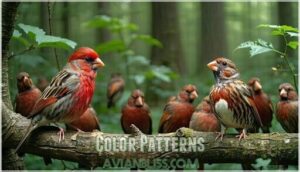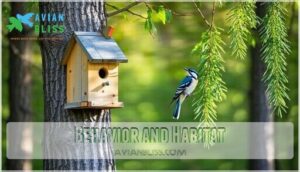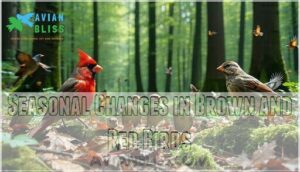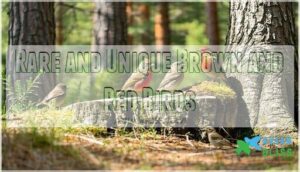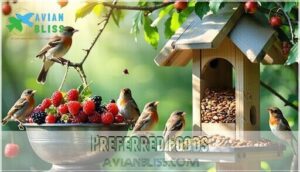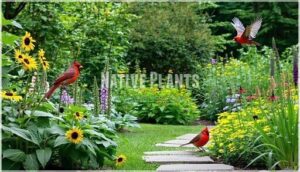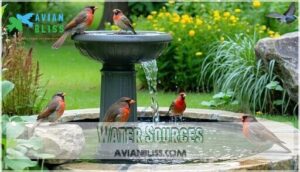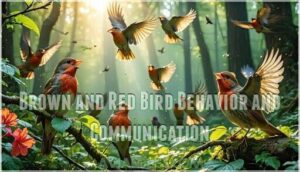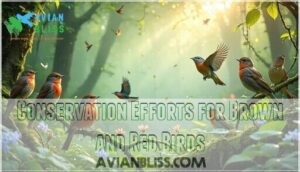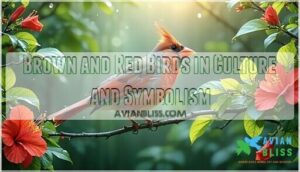This site is supported by our readers. We may earn a commission, at no cost to you, if you purchase through links.
 You’ll spot brown and red birds everywhere once you know what to look for.
You’ll spot brown and red birds everywhere once you know what to look for.
The Northern Cardinal’s bright red chest makes it a backyard favorite, while House Finches show off rosy patches on their heads and breasts.
Purple Finches wear deeper burgundy colors, and the stunning Vermilion Flycatcher flashes brilliant red against desert skies.
These warm colors aren’t just for show—they help birds attract mates and claim territory.
Brown base colors keep them camouflaged when needed.
From tiny finches to bold cardinals, these species adapt to different habitats across North America.
Knowing their unique patterns and behaviors reveals identification secrets.
These species are able to thrive in various environments, making them a backyard favorite and allowing them to attract mates and claim territory.
Table Of Contents
- Key Takeaways
- Common Brown and Red Birds in North America
- Identifying Brown Birds With Red Features
- Brown and Red Birds in Different Habitats
- Seasonal Changes in Brown and Red Birds
- Rare and Unique Brown and Red Birds
- Feeding Habits of Brown and Red Birds
- Attracting Brown and Red Birds to Your Yard
- Brown and Red Bird Behavior and Communication
- Conservation Efforts for Brown and Red Birds
- Brown and Red Birds in Culture and Symbolism
- Frequently Asked Questions (FAQs)
- What are brown birds with red heads?
- Are there Brown and Red Birds in North America?
- Are brown birds beautiful?
- Are there red coloured birds?
- What bird has a red crown?
- What does a small brown bird look like?
- What kind of bird is brown and red?
- What bird looks like a cardinal but is brown?
- What is the difference between a House Finch and a red robin?
- What does it mean to see a House Finch?
- Conclusion
Key Takeaways
- You’ll easily identify brown and red birds by focusing on three key features: their size and body shape, the specific location of red markings on their brown bodies, and the type of habitat where you spot them.
- You can attract cardinals, finches, and other colorful species to your yard by setting up tube feeders with sunflower seeds, providing fresh water sources, and planting native berry-producing shrubs.
- You’ll find different species in specific habitats – cardinals prefer dense woodlands and suburban areas, vermilion flycatchers thrive in desert scrublands, while house finches adapt well to urban environments and backyard feeders.
- You’ll notice these birds change their appearance seasonally, with males displaying brighter red plumage during breeding season and duller colors in winter, while juveniles start with muted brown feathers before developing adult coloration.
Common Brown and Red Birds in North America
You’ll find several brown and red birds across North America that are easy to spot in your backyard, local parks, and wooded areas.
The most common species include the bright red Northern Cardinal, the House Finch with its red head and brown body, the Purple Finch with raspberry-red coloring, the Vermilion Flycatcher, and the Scarlet Tanager.
These vibrant backyard visitors bring year-round color and song to North American landscapes, from desert scrublands to eastern woodlands.
Northern Cardinal
The Northern Cardinal stands out as North America’s most recognizable red bird. Males flash brilliant scarlet plumage while females show warm brown feathers with reddish tinges on wings and tail.
These year-round residents don’t migrate, so you’ll spot them in your yard through all seasons. Their rich Cardinal Songs fill morning air with clear whistles.
- Found across eastern United States in Cardinal Habitats from woodlands to suburbs
- Female Plumage features subtle brown tones with red accents on crest and wings
- Regional Variations show slight size differences across their range
- Strong Symbolism in many cultures represents hope and renewal
House Finch
You’ll recognize the House Finch by its cheerful red head and streaky brown body at your feeder.
These adaptable brown and red birds have mastered urban adaptation, thriving in cities and suburbs.
Males display varying red shades thanks to House Finch genetics and diet.
Their finch vocalizations include long, warbling songs that brighten any morning.
Watch their fascinating nesting behavior as they build homes in hanging plants and building crevices.
Purple Finch
Unlike House Finches with their streaky appearance, Purple Finches showcase stunning plumage variation – males display raspberry-red coloring while females sport brown streaking with distinct facial patterns.
These North American birds prefer coniferous forests as their habitat specifics, though they’ll visit backyard feeders during winter.
Their diet diversity includes seeds, insects, and fruits, supporting their nesting habits in evergreen trees.
Purple Finch identification features:
- Raspberry-red males with unstreaked sides
- Brown females with bold white eyebrows
- Cone-shaped bills perfect for seed cracking
- Warbling songs that flow smoothly unlike House Finch raspiness
Song uniqueness helps distinguish these finches from similar brown and red birds species.
Vermilion Flycatcher
When you spot a Vermilion Flycatcher in desert habitat, you’ll witness nature’s perfect contrast.
Male plumage blazes brilliant red from head to belly, while female variation shows subtle brown tones with peachy undertones.
These red birds excel at flycatching behavior, darting from perches to snatch insects mid-air.
Their insect diet makes them valuable pest controllers.
Among brown and red birds, this bird species stands out for easy bird identification in southwestern riparian areas.
Males use their vibrant colors during elaborate courtship displays.
Scarlet Tanager
After observing the vermilion flycatcher’s desert antics, you’ll encounter the Scarlet Tanager deep in eastern forests.
Male scarlet tanagers showcase brilliant red bodies with jet-black wings during breeding season, making them unmistakable among red birds.
Female plumage appears yellow-green, perfectly camouflaged in forest canopy.
These brown and red birds maintain an insect diet, catching prey mid-flight like skilled acrobats.
Their forest habitat spans mature deciduous woodlands from Canada to Georgia.
Migration patterns take them to South America each winter.
Listen for their distinctive "chip-burr" call echoing through treetops.
Conservation status remains stable, though bird identification requires patience since they prefer high branches.
This bird species exemplifies nature’s artistry.
Identifying Brown Birds With Red Features
You’ll need to look beyond just color to identify brown birds with red features since many species share similar patterns.
Focus on three key areas: the bird’s overall size and body shape, where exactly the red appears on its brown body, and what type of habitat you’re observing it in, to help you accurately identify the species, considering complete concepts about the bird’s characteristics.
Size and Shape
Bird size and bill shape are your first clues to identification.
Body proportions reveal key differences between species – finches have compact builds while tanagers appear longer.
Beak morphology varies dramatically: cardinals sport thick seed-cracking bills, flycatchers have pointed insect-catching beaks.
Wing shape and tail length distinguish ground-feeders from aerial hunters, and these physical features matter more than colors alone.
Color Patterns
Color patterns help you identify brown and red birds with confidence.
Male House Finches show red feathers on their heads and breasts, while females display brown streaking.
Plumage variation creates stunning differences – some males appear orangish rather than bright red due to color genetics.
These brown and red birds use bird coloration as camouflage strategies, blending into tree bark and foliage.
Regional differences affect intensity, with desert birds often showing more vibrant red feathers than forest dwellers.
Small brown birds often exhibit subtle plumage shades.
Behavior and Habitat
When studying brown and red birds, you’ll notice distinct bird behavior patterns that reveal their identity.
House Finches display social behavior at feeders, while Cardinals show territorial behavior in dense shrubs.
Migration patterns differ greatly – some species stay year-round while others travel seasonally.
Understanding nesting habits, foraging behavior, and bird communication helps distinguish similar species in their preferred bird habitat.
Brown and Red Birds in Different Habitats
You’ll find brown and red birds in nearly every habitat across North America, from dense woodlands to open deserts.
Each environment shapes which species you’re likely to spot, with cardinals preferring wooded areas while vermilion flycatchers thrive in desert scrublands.
Woodland Species
When you venture into forest habitats, you’ll discover several brown birds and red bird species that call these wooded areas home.
These redheaded birds have mastered unique survival strategies that showcase fascinating nesting behavior and predator avoidance techniques.
Northern Cardinal
Lewis’s Woodpecker
Hepatic Tanager
Here’s what makes woodland species special:
- Diet overlap occurs when multiple species feed on similar insects and seeds
- Conservation status varies, with some woodpeckers facing habitat loss challenges
- Nesting behavior includes cavity excavation and dense shrub preference
Your bird identification guide becomes essential when distinguishing these woodland treasures. Supplementing their natural diet with suitable feeder options can also support these birds.
Desert Dwellers
From woodland shade, we shift to scorching desert habitats where brown and red birds have mastered extreme survival.
These hardy species showcase remarkable Arid Adaptations and Water Conservation strategies that’ll amaze you.
Many desert birds benefit from a reliable water source.
Desert Diet specialists thrive here through clever Nesting Strategies and Predator Avoidance techniques:
- Vermilion Flycatcher males flash brilliant red plumage while hunting insects in desert scrubland
- Arizona Woodpecker carves homes in desert oaks, feeding on beetle larvae and acorns
- Gila woodpecker excavates saguaro cactus nests, getting moisture from fruits
These bird diets perfectly match harsh desert conditions.
Backyard Visitors
Transform your backyard into a bird paradise with simple additions.
House finch and Northern Cardinal frequent yards with proper setup.
Bird feeders filled with sunflower seeds attract these brown and red birds consistently.
Bird baths provide essential water sources, while nesting boxes offer shelter.
Predator control and window collision prevention keep visitors safe.
Enhancing your yard with backyard bird feeders can substantially increase avian visitors.
Bird-friendly gardens with native plants create natural habitats for backyard bird watching enthusiasts.
| Bird Species | Preferred Feeder Type | Best Food Options |
|---|---|---|
| House Finch | Tube feeders | Sunflower seeds, nyjer |
| Northern Cardinal | Platform feeders | Safflower seeds, cracked corn |
| Red-winged Blackbird | Ground feeders | Mixed seeds, suet |
| Purple Finch | Hopper feeders | Black-oil sunflower seeds |
| Scarlet Tanager | Fruit feeders | Oranges, grape jelly |
The table provides a summary of preferred feeder types and best food options for different bird species, including the House Finch, Northern Cardinal, Red-winged Blackbird, Purple Finch, and Scarlet Tanager.
This information can be used to create a bird-friendly environment in your backyard.
Coastal and Wetland Birds
Coastal wetlands showcase stunning red bird identification opportunities.
Red-winged Blackbirds breed in fresh and salt marshes, while types of brown birds like Tricolored Herons hunt along river edges.
These common brown birds display remarkable Ibis Adaptations and Marsh Foraging techniques.
Flamingo Coloration comes from carotenoids in their diet, creating those iconic pink hues.
Spoonbill Diet varies across wetland zones.
These habitats remain essential for Avian Conservation efforts protecting birds with red feathers.
Seasonal Changes in Brown and Red Birds
You’ll notice many brown and red birds change their colors throughout the year, with males often showing brighter reds during breeding season and duller tones in winter.
These seasonal shifts help you identify the same species at different times, as juvenile birds typically display muted brown plumage before developing their adult colors, which can include brighter reds.
Breeding Plumage
During breeding cycles, many brown birds with red heads undergo stunning transformations.
You’ll witness dramatic plumage colors emerge as males develop vibrant plumage for courtship displays.
The red crossbill intensifies its crimson tones, while feather patterns become more defined.
These mating rituals depend on striking red feathers that catch potential mates’ attention.
Brown bird plumage shifts from subdued winter tones to eye-catching breeding colors, creating nature’s most spectacular seasonal makeover for successful reproduction.
Understanding bird behavior patterns is essential for appreciating these transformations.
Winter Coloration
When breeding season ends, brown birds with red heads swap their vibrant plumage for winter wardrobes. You’ll watch male cardinals fade from brilliant scarlet to muted rust tones through molting patterns that protect them during cold months. This color fading isn’t just beautiful—it’s a survival strategy.
Winter camouflage helps these feathered friends blend with bare branches and snowy landscapes. The changes in their appearance are crucial for their survival during the harsh winter months.
- Plumage changes occur through complete feather loss in late summer
- Red feathers become brownish or orange-tinted
- Bird plumage variations help species avoid predators
- Bird wintering grounds require different survival tactics than breeding territories, which is a key aspect of their overall winter camouflage.
Juvenile Plumage
Young brown birds with red heads start life looking nothing like their flashy parents.
Juvenile plumage appears duller and more mottled, with feather development creating streaky plumage patterns.
These fledgling characteristics provide camouflage while they master survival skills.
Coloration changes happen gradually through molt cycles, transforming drab youngsters into vibrant adults.
Bird plumage variations help you identify different ages of brown birds and understand bird species characteristics.
Rare and Unique Brown and Red Birds
You’ll find some of the most special brown and red birds hiding in remote forests and desert regions across North America.
These uncommon species include the Red Crossbill with its twisted bill for opening pinecones, the chunky Pine Grosbeak that visits backyards only in winter, the desert-loving Pyrrhuloxia that looks like a gray cardinal, and the Hepatic Tanager that prefers mountain forests.
Red Crossbill
Red Crossbill finches roam coniferous forests like feathered nomads, their crossed bills perfectly designed for seed extraction from stubborn pinecones.
You’ll recognize males by their brick-red plumage contrasting with dark wings, while females sport olive-brown coloring with reddish highlights.
Their specialized beak structure works like nature’s pliers, prying open cones other birds can’t access.
These brown birds with red heads follow food sources across vast distances, making them unpredictable visitors to any location.
- Crossed mandibles create leverage for pinecone feeding efficiency
- Irregular movements follow conifer seed crop abundance patterns
- Year-round breeding occurs whenever food sources are plentiful
- Distinct call types match specific conifer species preferences perfectly
Pine Grosbeak
Unlike the Red Crossbill’s specialized cone-cracking lifestyle, the Pine Grosbeak roams boreal forests as North America’s largest finch.
You’ll recognize males by their rose-red bodies and dark wings with white bars. Females sport mustard-yellow plumage instead.
These robin-sized birds practice irregular Bird Migration patterns, following food sources across northern territories.
Their Grosbeak Diet includes fruits, seeds, and buds, making them important for Seed Dispersal in Forest Ecology systems.
Pyrrhuloxia
Spotting a Pyrrhuloxia feels like discovering a hidden gem in America’s desert landscapes.
This "desert cardinal" thrives in thorny Pyrrhuloxia Habitat across Arizona and Texas, where Desert Adaptation helps it survive harsh conditions.
Unlike Northern Cardinal relatives, males sport gray bodies with striking Red Plumage on face and wings.
Their distinctive curved yellow bills make bird identification easier when distinguishing these unique brown birds from other red birds.
Hepatic Tanager
Southwest highlands host the Hepatic Tanager, a master of mountain forests.
Males sport brick-red plumage while females display olive-yellow tones.
These red birds prefer pine-oak woodlands from Arizona to Mexico.
Their robust beak structure helps them catch insects mid-flight.
Listen for their distinctive bird song echoing through canyons.
Tanager migration patterns remain limited, making sightings special for dedicated birders seeking these elusive beauties.
Feeding Habits of Brown and Red Birds
You’ll discover that brown and red birds have remarkably different eating habits, from seed-cracking finches at your feeder to flycatchers that snatch insects mid-air.
These feeding preferences directly influence where you’ll spot each species and what foods you can offer to attract them to your yard, based on their unique habits and feeding preferences.
Seed Eaters
Among brown and red birds, seed types matter more than you’d think.
Finches crack tiny nyjer seeds with their pointed beaks, while cardinals use powerful jaws for sunflower shells.
These beak shapes reveal their feeding strategies perfectly.
House finches prefer millet and safflower seeds, showing distinct foraging habits.
Understanding each species’ dietary needs helps you attract specific visitors.
Brown bird diet varies substantially – some ground-feed, others perch-feed, creating diverse bird feeding habits in your yard.
By offering the right seed eating options, you can support a wide range of species and enhance your bird-watching experience.
Insectivores
Many brown and red birds have mastered the art of hunting insects with their specialized bird beaks and remarkable foraging strategies.
You’ll find these skilled hunters using diverse bird foraging techniques to capture their prey. Vermilion Flycatchers showcase perfect insectivorous diet habits by catching flies mid-air, while Scarlet Tanagers hunt beetles high in forest canopies.
Their nesting behaviors often revolve around insect-rich areas to feed growing chicks.
- Aerial acrobats like flycatchers snatch insects during impressive mid-flight maneuvers
- Canopy hunters forage through leaves using precise bird foraging behavior patterns
- Ground gleaners hop along searching for hidden insect sources beneath fallen debris
Fruit and Berry Consumers
Several brown birds with red markings excel as fruit eaters and berry consumers.
Northern Cardinals munch on dogwood berries, wild grapes, and mulberries throughout the year.
Scarlet Tanagers switch from insects to fruits during migration, helping with seed dispersal as they travel.
Purple Finches feast on small berries and tree fruits, especially in winter months.
These red bird diet preferences make them excellent natural gardeners, spreading seeds across different habitats through their foraging behavior.
Nectar Feeders
Nature’s sweetest bird feeders come in feathered packages! Brown bird species like certain warblers occasionally visit flowers, while red bird diet includes nectar for specialized feeders.
You’ll attract these sugar-loving visitors with proper equipment and fresh sugar water.
- Nectar Plants: Plant bee balm, cardinal flower, and trumpet vine for natural feeding stations
- Flower Shapes: Tubular blooms match Bird Beaks perfectly for efficient nectar extraction
- Feeding Tubes: Clean hummingbird feeders weekly to prevent harmful bacteria growth
- Sugar Water: Mix four parts water to one part white sugar for ideal bird nutrition
Attracting Brown and Red Birds to Your Yard
You can turn your backyard into a magnet for colorful cardinals, finches, and other brown and red birds by offering the right food, water, and shelter.
Setting up seed feeders with sunflower seeds, planting native berry bushes, and providing fresh water sources will bring these beautiful birds right to your window, creating a haven for colorful cardinals, finches, and other birds.
Suitable Feeders
Getting the right feeder types makes all the difference for brown birds like cardinals and finches.
Seed tube feeders work perfectly for house finches, while hopper feeders attract cardinals and grosbeaks.
Platform feeders welcome ground-feeding species, and suet feeders draw woodpeckers with red caps.
Consider feeding heights – place feeders at different levels since some brown bird names prefer ground feeding while others perch higher.
Smart bird feeders placement transforms your backyard birding experience into consistent bird watching tips success.
Preferred Foods
Your backyard buffet can become a magnet for brown and red birds with the right seed preferences and fruit diets. These colorful visitors have specific tastes that change throughout the year.
Here are three essential food groups to offer:
- Oil sunflower seeds and safflower seeds – Cardinals and finches can’t resist these protein-packed options
- Fresh berries and dried fruits – Perfect for berry consumption during migration seasons
- Live mealworms – Excellent insect feeding source for protein-hungry parents during nesting
Native Plants
Beyond providing quality seeds, your garden design choices can make or break your bird conservation efforts.
Native plant species create the backbone of healthy bird habitats, supporting brown birds and red birds through natural seed selection and wildlife support.
Smart gardeners focus on ecosystem balance by choosing plants that deliver year-round resources:
- Berry-producing shrubs like elderberry and serviceberry feed cardinals and finches
- Seed-heavy flowers including native sunflowers and coneflowers attract house finches
- Undergrowth plants provide nesting sites and insect protein sources
- Chemical-free zones protect bird habitat preservation from harmful pesticides
Water Sources
The right water sources transform your yard into a magnet for brown and red bird species.
Birdbaths, especially heated ones for winter, provide year-round hydration that brown birds like cardinals and finches desperately need. Moving water features create irresistible sounds – think bubblers or small fountains that mimic natural stream ecology.
Place multiple water sources at different heights near bird nesting locations and feeders. Shallow dishes work perfectly for smaller species, while deeper basins attract larger birds.
Bird habitats thrive when you maintain clean, fresh water free from contaminants. Consider pond management principles – change water regularly to prevent algae growth. Position sources away from reflective windows but close to native shrubs where birds feel safe drinking and bathing.
Brown and Red Bird Behavior and Communication
You’ll notice brown and red birds use different sounds, movements, and displays to talk with each other and claim their space.
These birds show off bright red feathers during mating season, sing loud songs to mark territory, and gather in flocks with specific social rules that help them survive, using bright red feathers to communicate.
Mating Rituals
Looking for love, brown and red birds showcase fascinating courtship displays that reveal nature’s romance.
You’ll witness incredible bird mating behaviors right in your backyard.
Here’s what to watch for during breeding season:
- Male cardinals perform song-flight displays with rapid wingbeats while descending toward females
- Female cardinals hold open-wing displays with bodies upright during pair bonding
- House finch males serenade potential mates with elaborate twittering songs for mate selection
- Both cardinal sexes coordinate nesting rituals through unique territorial songs
Territorial Displays
After courtship rituals, brown and red birds shift to defending their turf.
Cardinals chase intruders from small territories around their nests, using aggressive calls and physical displays.
These agonistic displays involve crest raising and wing spreading to show dominance.
Border disputes occur when territories overlap, leading to dramatic aerial chases.
Males patrol boundaries constantly during breeding season, ensuring safe nesting behaviors for their mates through persistent territorial marking and defensive posturing, which helps maintain their nesting areas secure.
Vocalizations and Songs
Cardinals aren’t just showing off with displays—they’re also vocal virtuosos with incredible melodic structures.
Female cardinals actually sing more elaborate songs than males, breaking songbird stereotypes.
Their vocalizations serve multiple purposes beyond simple chirping behaviors.
Bird calls and song patterns include:
- Territorial songs that establish boundaries
- Courtship displays featuring complex melodies
- Coordination calls between mates at nests
- Alarm calls warning of nearby predators
Each species develops unique vocal learning abilities.
Flock Dynamics
When winter arrives, brown and red birds transform into fascinating social communities that showcase remarkable flock behavior.
Cardinals join mixed-species flocks for safety, while their social hierarchy emerges during feeding times through subtle dominance displays.
You’ll witness incredible group coordination as these birds navigate:
- Foraging strategies that reduce competition through spacing
- Alarm calls that mobilize entire flocks against predators
- Communal roosting sites shared among different species
- Bird migration patterns influenced by flock decisions
Their bird social behavior reveals complex communication systems where individual survival depends on collective intelligence and cooperative breeding strategies.
Conservation Efforts for Brown and Red Birds
You can help protect brown and red birds by supporting habitat preservation efforts and participating in citizen science projects that track bird populations.
Climate change threatens many species like the Vermilion Flycatcher and Scarlet Tanager, but conservation programs work to save their nesting areas and create safe migration routes.
Threatened Species
Several brown birds and red birds face serious population drops.
Endangered Finches like the House Finch struggle with Habitat Loss across North America.
Bird Extinction threatens over 25% of species in fifty years.
Red Bird Decline affects cardinals and tanagers nationwide.
| Species | Conservation Status | Main Threat |
|---|---|---|
| Brown Kiwi | Endangered | Habitat destruction |
| House Finch | Declining | Urban development |
| Scarlet Tanager | Vulnerable | Forest fragmentation |
Species Conservation requires immediate action from bird conservation efforts supporting threatened bird species.
Habitat Preservation
Protecting bird sanctuaries builds upon threatened species recovery efforts, focusing on long-term ecosystem management. Wildlife conservation requires dedicated habitat preservation strategies.
You can support bird habitat conservation through:
- Advocating for forest restoration projects that rebuild nesting sites
- Supporting wetland preservation initiatives that protect feeding grounds
- Participating in biodiversity protection programs in your community
- Creating wildlife-friendly spaces that connect fragmented habitats
Bird habitat restoration isn’t just about saving individual species—it’s about nurturing bird habitats in North America where colorful cardinals and finches thrive for generations.
Climate Change Impacts
While habitat preservation lays the groundwork for bird conservation, the looming threat of climate change presents new challenges that can’t be ignored.
Temperature shifts are pushing brown and red birds into uncharted territory. You’re witnessing species like the Scarlet Tanager moving northward as their preferred climates migrate.
Migration patterns have become unpredictable—some birds arrive weeks earlier than usual, while others skip migration entirely.
Extreme weather events hit these birds hard. Heat waves stress breeding adults, while droughts shrink insect populations that many species depend on.
Sea level rise threatens coastal habitats where species like the Painted Bunting winter.
Habitat loss accelerates as changing precipitation patterns alter forest composition. The bird population trends you observe today reflect these mounting pressures, with nearly two-thirds of North American species facing climate-related risks.
Citizen Science Projects
Through citizen science projects, you’re joining a powerful bird watching community that shapes bird species conservation status.
These conservation tracking initiatives transform casual observations into valuable data analysis for researchers.
Here’s how you can contribute to bird watching data collection:
- Bird Surveys like Christmas Bird Count create lifelong memories with family
- Species Mapping through eBird helps protect your favorite local birding spots
- Community Engagement connects you with passionate birders who share your love
- Bird watching citizen science gives your hobby deeper meaning and purpose
- Bird conservation initiatives guarantee future generations enjoy these beautiful creatures
Brown and Red Birds in Culture and Symbolism
You’ll find brown and red birds carry deep meaning across many cultures, from Native American traditions that honor cardinals as messengers to religious symbols of hope and renewal.
These colorful species have earned special recognition as state birds and appear in countless stories, artwork, and spiritual practices throughout human history.
Native American Traditions
Throughout generations, red birds carry deep meaning in Spiritual Beliefs across many tribes.
Native American bird species like cardinals appear in Tribal Legends as messengers from the spirit world. Ancient Stories tell how these vibrant creatures bring hope during difficult times.
Cultural Symbols vary among tribes, but common themes emerge:
Spiritual messenger
Native Rituals often honor these bird species diversity as sacred connections between earth and sky.
Religious Symbolism
Biblical Birds like the Northern Cardinal hold profound Spiritual Meaning across many faiths.
Their Red Symbolism represents Christ’s blood and divine love, making them powerful Divine Messengers.
When you spot these crimson creatures during winter, they’re often seen as heavenly visitors bringing comfort and hope.
Sacred Feathers carry these spiritual messages:
- Faith and strength during difficult times
- Divine presence in your daily life
- Messages from departed loved ones watching over you
Cardinals remind us that we’re never truly alone.
State Birds
Beyond their spiritual meaning, brown and red birds serve as powerful Official Symbols across America.
You’ll find these Bird Emblems proudly displayed on State Flags and government buildings nationwide.
The Northern Cardinal reigns supreme among Regional Birds, representing seven states including Illinois, Indiana, Kentucky, North Carolina, Ohio, Virginia, and West Virginia.
These crimson Avian Icons embody hope and resilience in local cultures.
Other brown and red species like the Red Crossbill, Cassins Finch, Purple Finch, and Redfaced Warbler hold regional significance in western states.
| State | Bird Emblem | Year Adopted |
|---|---|---|
| Illinois | Northern Cardinal | 1929 |
| Kentucky | Northern Cardinal | 1926 |
| Ohio | Northern Cardinal | 1933 |
These selections reflect community values and local ecosystems, connecting residents to their natural heritage.
Frequently Asked Questions (FAQs)
What are brown birds with red heads?
You’d think spotting brown birds with red heads would be rare, but they’re actually common backyard visitors.
House Finches sport vibrant red faces on brown bodies, while Purple Finches show raspberry-red crowns.
Cardinals display brilliant red crests too.
Are there Brown and Red Birds in North America?
Yes, you’ll find several brown and red birds across North America.
House Finches, Purple Finches, and Northern Cardinals are common examples.
Male finches display vibrant red heads with brown bodies, while cardinals show brilliant red plumage.
Are brown birds beautiful?
Like hidden gems scattered across nature’s canvas, brown birds possess their own quiet elegance.
You’ll discover their understated charm in intricate feather patterns, graceful movements, and melodic songs that make them absolutely stunning in their natural simplicity.
Are there red coloured birds?
Red birds absolutely exist and they’re stunning.
You’ll spot brilliant Northern Cardinals, vibrant House Finches, and gorgeous Scarlet Tanagers.
These crimson beauties brighten backyards everywhere with their eye-catching plumage and cheerful songs.
What bird has a red crown?
Several bird species sport striking red crowns that’ll catch your eye instantly.
You’ll spot Northern Cardinals, Acorn Woodpeckers, Arizona Woodpeckers, and Common Redpolls flashing their crimson caps while foraging in your backyard or local parks.
What does a small brown bird look like?
Small brown birds typically show streaked or mottled plumage with darker brown markings across their backs and wings.
You’ll notice their compact size, pointed beaks, and often see subtle variations in brown shades throughout their feathers.
What kind of bird is brown and red?
You’re likely spotting a House Finch or Northern Cardinal.
Male House Finches display brown bodies with bright red heads and chests, while male Cardinals show vibrant red plumage with distinctive black face masks.
What bird looks like a cardinal but is brown?
You’re absolutely stumped by that mystery bird!
The Pyrrhuloxia is your answer – it’s basically a desert cardinal’s cousin with grayish-brown feathers and subtle red accents that’ll fool you every time.
What is the difference between a House Finch and a red robin?
House finches are smaller songbirds with curved beaks, red heads, and brown bodies.
Robins are larger thrushes with straight yellow beaks, red breasts, and dark gray backs.
You’ll spot different body shapes and feeding behaviors too.
What does it mean to see a House Finch?
Spotting one signals good fortune approaching your doorstep.
These cheerful birds represent joy, community, and fresh starts in many cultures.
You’re likely entering a period of positive change, new friendships, and abundant opportunities ahead.
Conclusion
Over 50 million American households feed wild birds, creating countless opportunities to spot these colorful visitors.
You’ve now learned to identify brown and red birds through their unique patterns, behaviors, and habitats.
From cardinals brightening winter days to finches gathering at feeders, these species offer year-round viewing pleasure.
Start with common backyard visitors, then expand your search to woodlands and wetlands.
With practice, you’ll confidently recognize these beautiful brown and red birds wherever your adventures take you.


